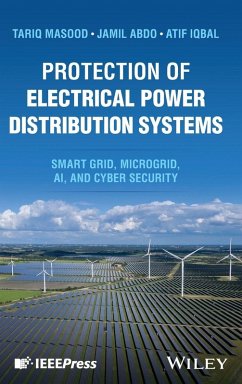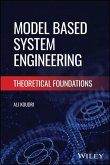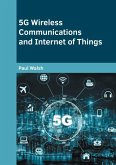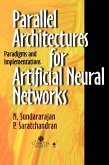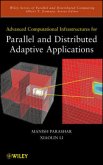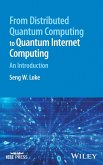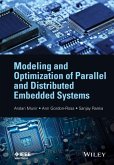Tariq Masood
Protection of Electrical Power Distribution Systems
Tariq Masood
Protection of Electrical Power Distribution Systems
- Gebundenes Buch
- Merkliste
- Auf die Merkliste
- Bewerten Bewerten
- Teilen
- Produkt teilen
- Produkterinnerung
- Produkterinnerung
Comprehensive reference on safeguarding electrical power systems from faults and failures, exploring emerging technologies such as AI and ML Supported by case studies of real-world power system faults, Protection of Electrical Power Distribution Systems offers an in-depth examination of the methods and technologies used to safeguard electrical grids from faults and failures. The book begins with a comprehensive introduction to power system fundamentals, emphasizing the critical role of protection mechanisms in maintaining system stability and ensuring operational safety. It thoroughly explores…mehr
Andere Kunden interessierten sich auch für
![Model Based System Engineering Model Based System Engineering]() Ali KoudriModel Based System Engineering116,99 €
Ali KoudriModel Based System Engineering116,99 €![5g Wireless Communications and Internet of Things 5g Wireless Communications and Internet of Things]() 5g Wireless Communications and Internet of Things130,99 €
5g Wireless Communications and Internet of Things130,99 €![Mobile Technology for Children Mobile Technology for Children]() Allison DruinMobile Technology for Children48,99 €
Allison DruinMobile Technology for Children48,99 €![Parallel Architectures ANNs Parallel Architectures ANNs]() N. SundararajanParallel Architectures ANNs129,99 €
N. SundararajanParallel Architectures ANNs129,99 €![Advanced Computational Infrastructures for Parallel and Distributed Adaptive Applications Advanced Computational Infrastructures for Parallel and Distributed Adaptive Applications]() Manish ParasharAdvanced Computational Infrastructures for Parallel and Distributed Adaptive Applications173,99 €
Manish ParasharAdvanced Computational Infrastructures for Parallel and Distributed Adaptive Applications173,99 €![From Distributed Quantum Computing to Quantum Internet Computing From Distributed Quantum Computing to Quantum Internet Computing]() Seng W LokeFrom Distributed Quantum Computing to Quantum Internet Computing116,99 €
Seng W LokeFrom Distributed Quantum Computing to Quantum Internet Computing116,99 €![Modeling and Optimization of Parallel and Distributed Embedded Systems Modeling and Optimization of Parallel and Distributed Embedded Systems]() Arslan MunirModeling and Optimization of Parallel and Distributed Embedded Systems117,99 €
Arslan MunirModeling and Optimization of Parallel and Distributed Embedded Systems117,99 €-
-
-
Comprehensive reference on safeguarding electrical power systems from faults and failures, exploring emerging technologies such as AI and ML Supported by case studies of real-world power system faults, Protection of Electrical Power Distribution Systems offers an in-depth examination of the methods and technologies used to safeguard electrical grids from faults and failures. The book begins with a comprehensive introduction to power system fundamentals, emphasizing the critical role of protection mechanisms in maintaining system stability and ensuring operational safety. It thoroughly explores various types of faults, including short circuits, ground faults, and overloads, detailing their potential impacts on system performance, reliability, and safety. The book introduces foundational concepts such as protection overlay, unit protection, and non-unit protection, before diving into the core principles of power system protection. These include the key attributes of selectivity, sensitivity, speed, and reliability, essential for designing effective protection systems. A detailed discussion follows on the wide range of protective devices used in modern power systems, such as fuses, circuit breakers, and relays, along with strategies for their coordination to ensure optimal performance. To enhance reader engagement and understanding, the book includes practical exercises and self-assessment questions that focus on protection system design and implementation. These tools encourage deeper learning and provide valuable insights into the real-world application of power system protection technologies. Protection of Electrical Power Distribution Systems includes information on: * Differences between restricted and unrestricted protection and criteria to determine ideal boundaries of protection zones * Modern technologies applied to protection such as digital relays and intelligent electronic devices (IEDs) * Different kinds of busbar protection and the main types of faults affecting the busbar * Types of transformer protection and their constraints and the operation of current and voltage transformers * Future trends in the field such as the application of AI and ML in predictive maintenance and fault diagnosis Protection of Electrical Power Distribution Systems serves as an essential reference for engineers, researchers, and students, offering a deep understanding of power system protection principles and practices to enhance the reliability and safety of electrical power systems.
Produktdetails
- Produktdetails
- Verlag: John Wiley & Sons
- Seitenzahl: 432
- Erscheinungstermin: 21. Oktober 2025
- Englisch
- Abmessung: 229mm x 152mm x 24mm
- Gewicht: 721g
- ISBN-13: 9781394327645
- ISBN-10: 1394327641
- Artikelnr.: 72700464
- Herstellerkennzeichnung
- Libri GmbH
- Europaallee 1
- 36244 Bad Hersfeld
- gpsr@libri.de
- Verlag: John Wiley & Sons
- Seitenzahl: 432
- Erscheinungstermin: 21. Oktober 2025
- Englisch
- Abmessung: 229mm x 152mm x 24mm
- Gewicht: 721g
- ISBN-13: 9781394327645
- ISBN-10: 1394327641
- Artikelnr.: 72700464
- Herstellerkennzeichnung
- Libri GmbH
- Europaallee 1
- 36244 Bad Hersfeld
- gpsr@libri.de
Tariq Masood, M.Phil., PhD, P.E. is an Assistant Professor of Electrical Engineering at Frostburg State University, USA. He earned his PhD in Electrical Power System Smart Grid and Renewable Energies from the University of Bath, UK. Jamil Abdo, PhD, is a Professor and the Chair of the Department of Engineering at Frostburg State University, USA. He obtained his PhD in Mechanical Design from Southern Illinois University, Carbondale, USA. Atif Iqbal, DSc, PhD, is a Full Professor of the Department of Electrical Engineering at Qatar University, Qatar. He serves as the Vice-Chair of the IEEE Qatar Section, and is an Associate Editor of the IEEE Transactions on Industrial Electronics and Senior Editor of IEEE Access.
Author Biographies xix
Foreword xxi
Preface xxiii
Acknowledgments xxix
Definition/Abbreviations xxxix
Web Catalog xli
Exercises Discussed in this Book xliii
Figures Discussed in this Book xlix
Equations Discussed in this Book lv
Tables Discussed in this Book lvii
1 Introduction 1
1.1 Objectives 1
1.2 Introduction 1
2 The Protection Overlay 5
2.1 Objectives 5
2.2 Introduction 5
2.3 Nonunit Protection and Unit Protection 6
2.3.1 Nonunit or Nonrestricted Protection 7
2.3.1.1 Nonunit Protection Using Time for Discrimination 7
2.3.1.2 Nonunit Protection Not Using Time for Discrimination 8
2.3.2 Unit or Restricted Protection 8
2.4 Nonunit Protection and Unit Protection 10
2.5 Backup Protection 14
2.5.1 Primary and Secondary Protection Schemes 15
2.5.2 Dual Main Protection Schemes 16
2.6 Self-Assessments Questions 17
Bibliography 17
3 Nonunit Protection of Distribution Feeders 23
3.1 Objectives 23
3.2 Introduction 23
3.3 Fuses 24
3.3.1 Fuse Operating Characteristics 26
3.3.2 Protecting Radial Feeder Circuits with Fuses 28
3.3.3 Expulsion Fuse for Protecting Radial Feeder Circuits 31
3.3.4 Circuit Breaker-Assisted Fuse Protection Schemes 32
3.4 Overcurrent Relays 34
3.5 IDMT Overcurrent Relays 35
3.5.1 Operating Characteristics 35
3.5.2 Relay Types 37
3.5.2.1 Electromechanical Relays 37
3.5.2.2 Static (Analog) Relays 39
3.5.2.3 Digital Relays 40
3.5.3 Overcurrent Relay Setting 41
3.5.3.1 Protecting Feeder Circuits with IDMT Overcurrent Relays 42
3.5.3.2 The Relay Current Settings 43
3.5.3.3 Relay Time Settings 48
3.6 Instantaneous Overcurrent Relays 50
3.7 Conclusion 51
3.8 Self-Assessment Questions 52
3.8.1 Protecting Feeder Circuits Using IDMT Overcurrent Relays with
Instantaneous Elements 53
3.8.2 Protecting Feeder Circuits Using Directional Overcurrent Relays 54
3.8.3 Phase Fault Protection Using Directional Overcurrent Relays 56
3.8.4 Phase Fault Protection of Parallel Feeders 56
3.8.5 Phase Fault Protection of Ring Main Circuits 57
3.8.6 Earth Fault Protection Using Directional Overcurrent Relays 59
3.8.7 Computer-Based Overcurrent Relay Grading 61
Bibliography 61
4 Protection Transducers 67
4.1 Objectives 67
4.2 Introduction 67
4.3 Current Transformer (CT) 68
4.4 Voltage Transformer (VT) 71
4.5 Self-Assessment Questions 73
Bibliography 73
5 Unit Protection of Distribution Feeders 79
5.1 Objectives 79
5.2 Introduction 79
5.3 Conventional Differential Protection 80
5.4 Digital Differential Protection 83
5.5 Directional Earth Fault Protection 85
5.6 Rough Balance Protection 86
5.7 Self-Assessment Questions 89
Bibliography 90
6 Transformer Protection 95
6.1 Objectives 95
6.2 Introduction 95
6.2.1 Earth Fault 96
6.2.2 Phase Fault 96
6.2.3 Interturn Fault 98
6.2.4 Core Fault 98
6.3 Protection Overview 98
6.4 Differential Protection 99
6.4.1 Factors Affecting Differential Protection 99
6.4.2 Transformation Ratio 99
6.4.3 Phase Shifts in Delta/Star Windings 100
6.4.4 Tap Changing 102
6.4.5 Magnetic Inrush 103
6.5 Fuse Protection 107
6.6 Overcurrent Protection 108
6.7 Restricted Earth Fault Protection 108
6.8 Buchholz Protection 109
6.9 Winding Temperature Protection 110
6.10 Summary 110
6.11 Self-Assessment Questions 112
Bibliography 112
7 Busbar Protection 117
7.1 Objectives 117
7.2 Introduction 117
7.3 Busbar Fault Clearing Using Backup Protection 118
7.4 Frame-Earth Protection 118
7.4.1 Basic System 118
7.4.2 Frame-Earth with Check Relay 120
7.4.3 Frame-Earth Protection for Sectioned Busbar 120
7.4.4 Frame Earth Protection for Double Busbar Switchboard 122
7.5 Differential Protection 122
7.5.1 Basic Application 122
7.5.2 Differential Protection for Sectioned Substation 124
7.5.3 Differential Protection for Double Busbar Substation 125
7.5.4 High Impedance Relays for Differential Busbar Schemes 127
7.5.5 Stabilizing Resistance 127
7.5.6 Relay Setting Calculation 129
7.6 Self-Assessment Questions 131
Bibliography 131
8 Motor Protection 137
8.1 Objectives 137
8.2 Introduction 137
8.3 Motor Characteristics Involved in Protection 138
8.4 Stator Winding Protection 139
8.5 Overload Protection 140
8.6 Phase Unbalance Protection 141
8.7 Self-Assessment Questions 143
Bibliography 143
9 Embedded Generation Protection Systems 147
9.1 Objectives 147
9.2 Introduction 147
9.2.1 Embedded Generation 147
9.2.2 Types of Generation 148
9.3 Problem Introduced by Connecting Embedded Generating 150
9.3.1 Safety 150
9.3.2 Quality of Supply 151
9.3.3 Short-Circuit and Damage Prevention Protection 152
9.3.4 Protection Guidelines 153
9.4 Utility Protection Requirements for an Embedded Generator 154
9.4.1 Short-Circuit Protection for External Faults 154
9.4.2 Short-Circuit Protection for Internal Faults 154
9.4.3 Neutral Displacement Protection 155
9.4.4 Phase Unbalance Protection 156
9.4.5 Field Failure and Pole-Slipping Protection 156
9.4.6 Reverse Power Protection 158
9.4.7 Synchronization Control of the Connection Circuit Braker 159
9.4.8 Under-/Overvoltage and Under-/Over-frequency Protection 159
9.4.9 Loss of Grid Protection 159
9.4.10 Protection Supervision 164
9.5 Self-Assessment Questions 165
Bibliography 165
10 Autoreclose Relaying 169
10.1 Objectives 169
10.2 Introduction 169
10.2.1 The Main Cause of Faults on Overhead Distribution Lines 170
10.2.2 Transient, Semipermanent, and Permanent Faults 170
10.2.3 Fault Clearance 171
10.2.4 Circuit Breaker Operation 171
10.3 Autoreclosing Relays 172
10.3.1 The Single-Shot Autoreclosing Relay Sequence 172
10.3.2 Choice of Dead Time 174
10.3.3 Multiple-Shot Autoreclose Schemes 175
10.3.4 Check Synchronism Relays 178
10.4 Self-Assessment Questions 180
Bibliography 180
11 Coordinated Protection and Control 185
11.1 Objectives 185
11.2 Conventional Protection and Control Systems 185
11.3 Coordinated Protection and Control 188
11.4 Digital Technology 189
11.4.1 Digital Communications 189
11.4.2 Computer Networking 191
11.4.3 Communication Media for Data Communications 194
11.4.4 Digital Relays 194
11.5 Typical Structure of a Modern Coordinated Substation 195
11.6 Self-Assessment Questions 198
Bibliography 198
12 Smart Grid Operation & Control 203
12.1 Objectives 203
12.2 Introduction 203
12.2.1 Distributed Intelligence 204
12.2.2 Broadband Communication 204
12.3 Distribution System 205
12.4 The Smart Grid Ultimate Goal 206
12.5 Smart Grid Decentralized Versus Centralized Control 207
12.6 Distribution Automation (DA) 208
12.6.1 Communication Networks 209
12.6.2 Distribution Automation (DA) - FDIR 209
12.6.2.1 Fault Detection, Isolation, and Restoration (FDIR) 209
12.6.2.2 Radial Low-Voltage Networks 210
12.6.2.3 Voltage Measurement Schematic 211
12.6.3 Fault Detection, Isolation, and Restoration (FDIR) and FLISR 212
12.7 Volt-Var Optimization (VVO) 213
12.8 SCADA System 214
12.8.1 SCADA System Functions 216
12.8.2 SCADA System Outage Monitoring 216
12.9 Case Studies 217
12.9.1 Northern Virginia Electric Cooperative (NOVEC) 217
12.9.2 Electric Power Board of Chattanooga 218
12.9.3 Duke Energy 218
12.9.4 Consolidated Edison (Con Edison) 219
12.9.5 Centerpoint Energy 219
12.9.6 PPL Electric Utilities Corporation 220
12.9.7 Pepco - Dc 220
12.9.8 Southern Company 221
12.9.9 Wisconsin Power and Light Company (WPL) 221
12.9.10 Central Lincoln People's Utility District 222
12.9.11 Florida Power & LIG, HT Company (FPL) 222
12.10 Smart Grid System for PV and Wind 223
12.11 R&D Challenges 223
12.12 Standardization Efforts in Smart Grid Technologies 223
12.12.1 Key Organizations Involved in Standardization 224
12.12.2 Impact of Policies on Smart and Microgrid Operations 225
12.12.2.1 Renewable Energy Policies 225
12.12.2.2 Energy Efficiency and Demand Response 225
12.12.2.3 Cybersecurity and Privacy Regulations 225
12.13 Challenges in Regulatory and Standardization Implementation 226
12.13.1 Harmonization Across Regions 226
12.13.2 Regulatory Uncertainty 226
12.13.3 Balancing Innovation and Regulation 226
12.14 Future Directions in Regulatory and Standardization Efforts 227
12.15 Self-Assessment Questions 228
Bibliography 228
13 Microgrid Operation and Control 231
13.1 Objectives 231
13.2 Introduction 231
13.3 Classification of Microgrids 231
13.3.1 AC Microgrid Operations and Control 234
13.3.2 dc Microgrid Operations and Control 235
13.3.3 Hybrid Microgrid Operations and Control 236
13.4 Microgrid Control 238
13.5 Droop Control - Parallel Inverter in UPS System 241
13.5.1 Bidirectional DC/DC Converters 242
13.5.2 Droop Control - Parallel Inverter in UPS System 243
13.5.3 Droop Control - Battery Charging and Discharging Systems 243
13.5.4 Off-Grid and Island Microgrid 245
13.5.5 Different Types of Islanding 246
13.5.6 Grid Following Inverters 246
13.5.7 Grid-Forming Inverters 248
13.6 Short-Circuit Study 249
13.6.1 Advantages of Short-Circuit Ratio Study 249
13.6.2 Traditional Short-Circuit Ratio (SCR) Method 249
13.7 Strong and Weak Microgrid 249
13.8 Types of Circuit Breakers in the AC and DC Microgrid 250
13.8.1 Time Current Curve 252
13.8.1.1 Typical Example of TCCs 253
13.8.1.2 Terminology of LSI (Long Time, Short Time, and Instantaneous) 253
13.8.1.3 Time Current Curve - TCC-Time Band 256
13.8.1.4 Terminology of MCCB and LVPCB 256
13.8.1.5 TCC for MCCBs Normally 2 Settings 257
13.8.1.6 TCC for LVPCBs. Normally 5 Settings 258
13.8.1.7 TCC for Fuse 259
13.8.1.8 TCC - Peak Let-Through for Fuses 261
13.9 Low Voltage Trip Unit 262
13.10 Symmetrical and Asymmetrical 263
13.11 CB Selectivity or Coordination for Grid Operations 264
13.12 Microgrid Adaptive and Predictive Control Techniques 268
13.12.1 Control of Distributed Energy Resources (DERs) 269
13.12.1.1 Integration of DERs 269
13.12.1.2 Inverter-Based Control 269
13.13 Artificial Intelligence (AI) and Machine Learning (ML) in Grid
Control 269
13.13.1 AI and ml 269
13.13.2 Data Analytics 269
13.14 Coordination of Multiple Control Levels 270
13.14.1 Hierarchical Control Structures 270
13.14.2 Interoperability and Standardization 270
13.15 Regulatory and Standardization Aspects 270
13.15.1 Overview of Regulatory Frameworks 270
13.15.1.1 National and Regional Regulations 270
13.15.1.2 Market Structures and Economic Regulation 271
13.16 Self-Assessment Questions 272
Bibliography 272
14 Artificial Intelligence and Machine Learning's Industrial Application
275
14.1 Objectives 275
14.2 Thinking Probabilistic 275
14.3 AI Machine Power and Disruption 277
14.4 Designing Reliable Systems 279
14.5 Embracing Uncertainty 280
14.6 AI System Prediction Technology 280
14.7 AI Prediction Machine Rules 281
14.8 AI Model Architecture 281
14.9 AI Models Tutorials 282
14.9.1 AI Industrial Assessment Models 282
14.9.2 Introduction to Machine Learning in Microgrid Operations 284
14.9.3 Data Analytics in Microgrid Control 286
14.9.4 Machine Learning Applications in Microgrid Control 287
14.9.5 Case Studies and Practical Implementations 288
14.10 Challenges and Future Directions 290
14.11 Conclusion 292
14.12 Probability AI Models Configuration 294
14.13 Self-Assessments Questions 296
Bibliography 296
15 Cybersecurity and Information Program's Power System 297
15.1 Objectives 297
15.2 Introduction 298
15.3 Cybersecurity Operations 299
15.4 Cybersecurity Impact and Solution 299
15.4.1 Validate Process Mapping 301
15.4.2 Data Collection Frame 302
15.4.3 Data Collection - Introducing System Mapping 303
15.5 How Can You Help? 303
15.6 Cybersecurity Tailored Models 307
15.6.1 Project Plan Work For (IT Penetration Testing, Vulnerability, and
Risk Assessment Framework) 307
15.6.1.1 Operational Summary 307
15.6.1.2 Objectives 308
15.6.1.3 Scope of Work 308
15.6.1.4 Methodology 308
15.6.1.5 Tools Used 309
15.6.1.6 Assessment and Testing Environment 309
15.6.1.7 Finding Overview 309
15.6.1.8 Security Controls and Levels 310
15.6.1.9 Training Needs 310
15.6.1.10 Deliverables 310
15.6.1.11 Time Line 310
15.6.2 Scope of Work for (OT Penetration Testing, Vulnerability, and Risk
Assessment Framework) 310
15.6.2.1 Operational Summary 311
15.6.2.2 Planning and Preparation 311
15.6.2.3 Assessment Phase 311
15.6.2.4 Testing Phase 312
15.6.2.5 Reporting Phase 312
15.6.2.6 Remediation and Improvement 312
15.6.2.7 Continuous Monitoring and Follow-Up 313
15.6.2.8 Scope of Assessment 313
15.6.2.9 OT Environment Equipment List 314
15.7 Self-Assessment Questions 315
Bibliography 315
Self-Assessment Question's Answers Section-wise 317
Tutor Marked Assignments 343
About the Authors 347
Index 351
Foreword xxi
Preface xxiii
Acknowledgments xxix
Definition/Abbreviations xxxix
Web Catalog xli
Exercises Discussed in this Book xliii
Figures Discussed in this Book xlix
Equations Discussed in this Book lv
Tables Discussed in this Book lvii
1 Introduction 1
1.1 Objectives 1
1.2 Introduction 1
2 The Protection Overlay 5
2.1 Objectives 5
2.2 Introduction 5
2.3 Nonunit Protection and Unit Protection 6
2.3.1 Nonunit or Nonrestricted Protection 7
2.3.1.1 Nonunit Protection Using Time for Discrimination 7
2.3.1.2 Nonunit Protection Not Using Time for Discrimination 8
2.3.2 Unit or Restricted Protection 8
2.4 Nonunit Protection and Unit Protection 10
2.5 Backup Protection 14
2.5.1 Primary and Secondary Protection Schemes 15
2.5.2 Dual Main Protection Schemes 16
2.6 Self-Assessments Questions 17
Bibliography 17
3 Nonunit Protection of Distribution Feeders 23
3.1 Objectives 23
3.2 Introduction 23
3.3 Fuses 24
3.3.1 Fuse Operating Characteristics 26
3.3.2 Protecting Radial Feeder Circuits with Fuses 28
3.3.3 Expulsion Fuse for Protecting Radial Feeder Circuits 31
3.3.4 Circuit Breaker-Assisted Fuse Protection Schemes 32
3.4 Overcurrent Relays 34
3.5 IDMT Overcurrent Relays 35
3.5.1 Operating Characteristics 35
3.5.2 Relay Types 37
3.5.2.1 Electromechanical Relays 37
3.5.2.2 Static (Analog) Relays 39
3.5.2.3 Digital Relays 40
3.5.3 Overcurrent Relay Setting 41
3.5.3.1 Protecting Feeder Circuits with IDMT Overcurrent Relays 42
3.5.3.2 The Relay Current Settings 43
3.5.3.3 Relay Time Settings 48
3.6 Instantaneous Overcurrent Relays 50
3.7 Conclusion 51
3.8 Self-Assessment Questions 52
3.8.1 Protecting Feeder Circuits Using IDMT Overcurrent Relays with
Instantaneous Elements 53
3.8.2 Protecting Feeder Circuits Using Directional Overcurrent Relays 54
3.8.3 Phase Fault Protection Using Directional Overcurrent Relays 56
3.8.4 Phase Fault Protection of Parallel Feeders 56
3.8.5 Phase Fault Protection of Ring Main Circuits 57
3.8.6 Earth Fault Protection Using Directional Overcurrent Relays 59
3.8.7 Computer-Based Overcurrent Relay Grading 61
Bibliography 61
4 Protection Transducers 67
4.1 Objectives 67
4.2 Introduction 67
4.3 Current Transformer (CT) 68
4.4 Voltage Transformer (VT) 71
4.5 Self-Assessment Questions 73
Bibliography 73
5 Unit Protection of Distribution Feeders 79
5.1 Objectives 79
5.2 Introduction 79
5.3 Conventional Differential Protection 80
5.4 Digital Differential Protection 83
5.5 Directional Earth Fault Protection 85
5.6 Rough Balance Protection 86
5.7 Self-Assessment Questions 89
Bibliography 90
6 Transformer Protection 95
6.1 Objectives 95
6.2 Introduction 95
6.2.1 Earth Fault 96
6.2.2 Phase Fault 96
6.2.3 Interturn Fault 98
6.2.4 Core Fault 98
6.3 Protection Overview 98
6.4 Differential Protection 99
6.4.1 Factors Affecting Differential Protection 99
6.4.2 Transformation Ratio 99
6.4.3 Phase Shifts in Delta/Star Windings 100
6.4.4 Tap Changing 102
6.4.5 Magnetic Inrush 103
6.5 Fuse Protection 107
6.6 Overcurrent Protection 108
6.7 Restricted Earth Fault Protection 108
6.8 Buchholz Protection 109
6.9 Winding Temperature Protection 110
6.10 Summary 110
6.11 Self-Assessment Questions 112
Bibliography 112
7 Busbar Protection 117
7.1 Objectives 117
7.2 Introduction 117
7.3 Busbar Fault Clearing Using Backup Protection 118
7.4 Frame-Earth Protection 118
7.4.1 Basic System 118
7.4.2 Frame-Earth with Check Relay 120
7.4.3 Frame-Earth Protection for Sectioned Busbar 120
7.4.4 Frame Earth Protection for Double Busbar Switchboard 122
7.5 Differential Protection 122
7.5.1 Basic Application 122
7.5.2 Differential Protection for Sectioned Substation 124
7.5.3 Differential Protection for Double Busbar Substation 125
7.5.4 High Impedance Relays for Differential Busbar Schemes 127
7.5.5 Stabilizing Resistance 127
7.5.6 Relay Setting Calculation 129
7.6 Self-Assessment Questions 131
Bibliography 131
8 Motor Protection 137
8.1 Objectives 137
8.2 Introduction 137
8.3 Motor Characteristics Involved in Protection 138
8.4 Stator Winding Protection 139
8.5 Overload Protection 140
8.6 Phase Unbalance Protection 141
8.7 Self-Assessment Questions 143
Bibliography 143
9 Embedded Generation Protection Systems 147
9.1 Objectives 147
9.2 Introduction 147
9.2.1 Embedded Generation 147
9.2.2 Types of Generation 148
9.3 Problem Introduced by Connecting Embedded Generating 150
9.3.1 Safety 150
9.3.2 Quality of Supply 151
9.3.3 Short-Circuit and Damage Prevention Protection 152
9.3.4 Protection Guidelines 153
9.4 Utility Protection Requirements for an Embedded Generator 154
9.4.1 Short-Circuit Protection for External Faults 154
9.4.2 Short-Circuit Protection for Internal Faults 154
9.4.3 Neutral Displacement Protection 155
9.4.4 Phase Unbalance Protection 156
9.4.5 Field Failure and Pole-Slipping Protection 156
9.4.6 Reverse Power Protection 158
9.4.7 Synchronization Control of the Connection Circuit Braker 159
9.4.8 Under-/Overvoltage and Under-/Over-frequency Protection 159
9.4.9 Loss of Grid Protection 159
9.4.10 Protection Supervision 164
9.5 Self-Assessment Questions 165
Bibliography 165
10 Autoreclose Relaying 169
10.1 Objectives 169
10.2 Introduction 169
10.2.1 The Main Cause of Faults on Overhead Distribution Lines 170
10.2.2 Transient, Semipermanent, and Permanent Faults 170
10.2.3 Fault Clearance 171
10.2.4 Circuit Breaker Operation 171
10.3 Autoreclosing Relays 172
10.3.1 The Single-Shot Autoreclosing Relay Sequence 172
10.3.2 Choice of Dead Time 174
10.3.3 Multiple-Shot Autoreclose Schemes 175
10.3.4 Check Synchronism Relays 178
10.4 Self-Assessment Questions 180
Bibliography 180
11 Coordinated Protection and Control 185
11.1 Objectives 185
11.2 Conventional Protection and Control Systems 185
11.3 Coordinated Protection and Control 188
11.4 Digital Technology 189
11.4.1 Digital Communications 189
11.4.2 Computer Networking 191
11.4.3 Communication Media for Data Communications 194
11.4.4 Digital Relays 194
11.5 Typical Structure of a Modern Coordinated Substation 195
11.6 Self-Assessment Questions 198
Bibliography 198
12 Smart Grid Operation & Control 203
12.1 Objectives 203
12.2 Introduction 203
12.2.1 Distributed Intelligence 204
12.2.2 Broadband Communication 204
12.3 Distribution System 205
12.4 The Smart Grid Ultimate Goal 206
12.5 Smart Grid Decentralized Versus Centralized Control 207
12.6 Distribution Automation (DA) 208
12.6.1 Communication Networks 209
12.6.2 Distribution Automation (DA) - FDIR 209
12.6.2.1 Fault Detection, Isolation, and Restoration (FDIR) 209
12.6.2.2 Radial Low-Voltage Networks 210
12.6.2.3 Voltage Measurement Schematic 211
12.6.3 Fault Detection, Isolation, and Restoration (FDIR) and FLISR 212
12.7 Volt-Var Optimization (VVO) 213
12.8 SCADA System 214
12.8.1 SCADA System Functions 216
12.8.2 SCADA System Outage Monitoring 216
12.9 Case Studies 217
12.9.1 Northern Virginia Electric Cooperative (NOVEC) 217
12.9.2 Electric Power Board of Chattanooga 218
12.9.3 Duke Energy 218
12.9.4 Consolidated Edison (Con Edison) 219
12.9.5 Centerpoint Energy 219
12.9.6 PPL Electric Utilities Corporation 220
12.9.7 Pepco - Dc 220
12.9.8 Southern Company 221
12.9.9 Wisconsin Power and Light Company (WPL) 221
12.9.10 Central Lincoln People's Utility District 222
12.9.11 Florida Power & LIG, HT Company (FPL) 222
12.10 Smart Grid System for PV and Wind 223
12.11 R&D Challenges 223
12.12 Standardization Efforts in Smart Grid Technologies 223
12.12.1 Key Organizations Involved in Standardization 224
12.12.2 Impact of Policies on Smart and Microgrid Operations 225
12.12.2.1 Renewable Energy Policies 225
12.12.2.2 Energy Efficiency and Demand Response 225
12.12.2.3 Cybersecurity and Privacy Regulations 225
12.13 Challenges in Regulatory and Standardization Implementation 226
12.13.1 Harmonization Across Regions 226
12.13.2 Regulatory Uncertainty 226
12.13.3 Balancing Innovation and Regulation 226
12.14 Future Directions in Regulatory and Standardization Efforts 227
12.15 Self-Assessment Questions 228
Bibliography 228
13 Microgrid Operation and Control 231
13.1 Objectives 231
13.2 Introduction 231
13.3 Classification of Microgrids 231
13.3.1 AC Microgrid Operations and Control 234
13.3.2 dc Microgrid Operations and Control 235
13.3.3 Hybrid Microgrid Operations and Control 236
13.4 Microgrid Control 238
13.5 Droop Control - Parallel Inverter in UPS System 241
13.5.1 Bidirectional DC/DC Converters 242
13.5.2 Droop Control - Parallel Inverter in UPS System 243
13.5.3 Droop Control - Battery Charging and Discharging Systems 243
13.5.4 Off-Grid and Island Microgrid 245
13.5.5 Different Types of Islanding 246
13.5.6 Grid Following Inverters 246
13.5.7 Grid-Forming Inverters 248
13.6 Short-Circuit Study 249
13.6.1 Advantages of Short-Circuit Ratio Study 249
13.6.2 Traditional Short-Circuit Ratio (SCR) Method 249
13.7 Strong and Weak Microgrid 249
13.8 Types of Circuit Breakers in the AC and DC Microgrid 250
13.8.1 Time Current Curve 252
13.8.1.1 Typical Example of TCCs 253
13.8.1.2 Terminology of LSI (Long Time, Short Time, and Instantaneous) 253
13.8.1.3 Time Current Curve - TCC-Time Band 256
13.8.1.4 Terminology of MCCB and LVPCB 256
13.8.1.5 TCC for MCCBs Normally 2 Settings 257
13.8.1.6 TCC for LVPCBs. Normally 5 Settings 258
13.8.1.7 TCC for Fuse 259
13.8.1.8 TCC - Peak Let-Through for Fuses 261
13.9 Low Voltage Trip Unit 262
13.10 Symmetrical and Asymmetrical 263
13.11 CB Selectivity or Coordination for Grid Operations 264
13.12 Microgrid Adaptive and Predictive Control Techniques 268
13.12.1 Control of Distributed Energy Resources (DERs) 269
13.12.1.1 Integration of DERs 269
13.12.1.2 Inverter-Based Control 269
13.13 Artificial Intelligence (AI) and Machine Learning (ML) in Grid
Control 269
13.13.1 AI and ml 269
13.13.2 Data Analytics 269
13.14 Coordination of Multiple Control Levels 270
13.14.1 Hierarchical Control Structures 270
13.14.2 Interoperability and Standardization 270
13.15 Regulatory and Standardization Aspects 270
13.15.1 Overview of Regulatory Frameworks 270
13.15.1.1 National and Regional Regulations 270
13.15.1.2 Market Structures and Economic Regulation 271
13.16 Self-Assessment Questions 272
Bibliography 272
14 Artificial Intelligence and Machine Learning's Industrial Application
275
14.1 Objectives 275
14.2 Thinking Probabilistic 275
14.3 AI Machine Power and Disruption 277
14.4 Designing Reliable Systems 279
14.5 Embracing Uncertainty 280
14.6 AI System Prediction Technology 280
14.7 AI Prediction Machine Rules 281
14.8 AI Model Architecture 281
14.9 AI Models Tutorials 282
14.9.1 AI Industrial Assessment Models 282
14.9.2 Introduction to Machine Learning in Microgrid Operations 284
14.9.3 Data Analytics in Microgrid Control 286
14.9.4 Machine Learning Applications in Microgrid Control 287
14.9.5 Case Studies and Practical Implementations 288
14.10 Challenges and Future Directions 290
14.11 Conclusion 292
14.12 Probability AI Models Configuration 294
14.13 Self-Assessments Questions 296
Bibliography 296
15 Cybersecurity and Information Program's Power System 297
15.1 Objectives 297
15.2 Introduction 298
15.3 Cybersecurity Operations 299
15.4 Cybersecurity Impact and Solution 299
15.4.1 Validate Process Mapping 301
15.4.2 Data Collection Frame 302
15.4.3 Data Collection - Introducing System Mapping 303
15.5 How Can You Help? 303
15.6 Cybersecurity Tailored Models 307
15.6.1 Project Plan Work For (IT Penetration Testing, Vulnerability, and
Risk Assessment Framework) 307
15.6.1.1 Operational Summary 307
15.6.1.2 Objectives 308
15.6.1.3 Scope of Work 308
15.6.1.4 Methodology 308
15.6.1.5 Tools Used 309
15.6.1.6 Assessment and Testing Environment 309
15.6.1.7 Finding Overview 309
15.6.1.8 Security Controls and Levels 310
15.6.1.9 Training Needs 310
15.6.1.10 Deliverables 310
15.6.1.11 Time Line 310
15.6.2 Scope of Work for (OT Penetration Testing, Vulnerability, and Risk
Assessment Framework) 310
15.6.2.1 Operational Summary 311
15.6.2.2 Planning and Preparation 311
15.6.2.3 Assessment Phase 311
15.6.2.4 Testing Phase 312
15.6.2.5 Reporting Phase 312
15.6.2.6 Remediation and Improvement 312
15.6.2.7 Continuous Monitoring and Follow-Up 313
15.6.2.8 Scope of Assessment 313
15.6.2.9 OT Environment Equipment List 314
15.7 Self-Assessment Questions 315
Bibliography 315
Self-Assessment Question's Answers Section-wise 317
Tutor Marked Assignments 343
About the Authors 347
Index 351
Author Biographies xix
Foreword xxi
Preface xxiii
Acknowledgments xxix
Definition/Abbreviations xxxix
Web Catalog xli
Exercises Discussed in this Book xliii
Figures Discussed in this Book xlix
Equations Discussed in this Book lv
Tables Discussed in this Book lvii
1 Introduction 1
1.1 Objectives 1
1.2 Introduction 1
2 The Protection Overlay 5
2.1 Objectives 5
2.2 Introduction 5
2.3 Nonunit Protection and Unit Protection 6
2.3.1 Nonunit or Nonrestricted Protection 7
2.3.1.1 Nonunit Protection Using Time for Discrimination 7
2.3.1.2 Nonunit Protection Not Using Time for Discrimination 8
2.3.2 Unit or Restricted Protection 8
2.4 Nonunit Protection and Unit Protection 10
2.5 Backup Protection 14
2.5.1 Primary and Secondary Protection Schemes 15
2.5.2 Dual Main Protection Schemes 16
2.6 Self-Assessments Questions 17
Bibliography 17
3 Nonunit Protection of Distribution Feeders 23
3.1 Objectives 23
3.2 Introduction 23
3.3 Fuses 24
3.3.1 Fuse Operating Characteristics 26
3.3.2 Protecting Radial Feeder Circuits with Fuses 28
3.3.3 Expulsion Fuse for Protecting Radial Feeder Circuits 31
3.3.4 Circuit Breaker-Assisted Fuse Protection Schemes 32
3.4 Overcurrent Relays 34
3.5 IDMT Overcurrent Relays 35
3.5.1 Operating Characteristics 35
3.5.2 Relay Types 37
3.5.2.1 Electromechanical Relays 37
3.5.2.2 Static (Analog) Relays 39
3.5.2.3 Digital Relays 40
3.5.3 Overcurrent Relay Setting 41
3.5.3.1 Protecting Feeder Circuits with IDMT Overcurrent Relays 42
3.5.3.2 The Relay Current Settings 43
3.5.3.3 Relay Time Settings 48
3.6 Instantaneous Overcurrent Relays 50
3.7 Conclusion 51
3.8 Self-Assessment Questions 52
3.8.1 Protecting Feeder Circuits Using IDMT Overcurrent Relays with
Instantaneous Elements 53
3.8.2 Protecting Feeder Circuits Using Directional Overcurrent Relays 54
3.8.3 Phase Fault Protection Using Directional Overcurrent Relays 56
3.8.4 Phase Fault Protection of Parallel Feeders 56
3.8.5 Phase Fault Protection of Ring Main Circuits 57
3.8.6 Earth Fault Protection Using Directional Overcurrent Relays 59
3.8.7 Computer-Based Overcurrent Relay Grading 61
Bibliography 61
4 Protection Transducers 67
4.1 Objectives 67
4.2 Introduction 67
4.3 Current Transformer (CT) 68
4.4 Voltage Transformer (VT) 71
4.5 Self-Assessment Questions 73
Bibliography 73
5 Unit Protection of Distribution Feeders 79
5.1 Objectives 79
5.2 Introduction 79
5.3 Conventional Differential Protection 80
5.4 Digital Differential Protection 83
5.5 Directional Earth Fault Protection 85
5.6 Rough Balance Protection 86
5.7 Self-Assessment Questions 89
Bibliography 90
6 Transformer Protection 95
6.1 Objectives 95
6.2 Introduction 95
6.2.1 Earth Fault 96
6.2.2 Phase Fault 96
6.2.3 Interturn Fault 98
6.2.4 Core Fault 98
6.3 Protection Overview 98
6.4 Differential Protection 99
6.4.1 Factors Affecting Differential Protection 99
6.4.2 Transformation Ratio 99
6.4.3 Phase Shifts in Delta/Star Windings 100
6.4.4 Tap Changing 102
6.4.5 Magnetic Inrush 103
6.5 Fuse Protection 107
6.6 Overcurrent Protection 108
6.7 Restricted Earth Fault Protection 108
6.8 Buchholz Protection 109
6.9 Winding Temperature Protection 110
6.10 Summary 110
6.11 Self-Assessment Questions 112
Bibliography 112
7 Busbar Protection 117
7.1 Objectives 117
7.2 Introduction 117
7.3 Busbar Fault Clearing Using Backup Protection 118
7.4 Frame-Earth Protection 118
7.4.1 Basic System 118
7.4.2 Frame-Earth with Check Relay 120
7.4.3 Frame-Earth Protection for Sectioned Busbar 120
7.4.4 Frame Earth Protection for Double Busbar Switchboard 122
7.5 Differential Protection 122
7.5.1 Basic Application 122
7.5.2 Differential Protection for Sectioned Substation 124
7.5.3 Differential Protection for Double Busbar Substation 125
7.5.4 High Impedance Relays for Differential Busbar Schemes 127
7.5.5 Stabilizing Resistance 127
7.5.6 Relay Setting Calculation 129
7.6 Self-Assessment Questions 131
Bibliography 131
8 Motor Protection 137
8.1 Objectives 137
8.2 Introduction 137
8.3 Motor Characteristics Involved in Protection 138
8.4 Stator Winding Protection 139
8.5 Overload Protection 140
8.6 Phase Unbalance Protection 141
8.7 Self-Assessment Questions 143
Bibliography 143
9 Embedded Generation Protection Systems 147
9.1 Objectives 147
9.2 Introduction 147
9.2.1 Embedded Generation 147
9.2.2 Types of Generation 148
9.3 Problem Introduced by Connecting Embedded Generating 150
9.3.1 Safety 150
9.3.2 Quality of Supply 151
9.3.3 Short-Circuit and Damage Prevention Protection 152
9.3.4 Protection Guidelines 153
9.4 Utility Protection Requirements for an Embedded Generator 154
9.4.1 Short-Circuit Protection for External Faults 154
9.4.2 Short-Circuit Protection for Internal Faults 154
9.4.3 Neutral Displacement Protection 155
9.4.4 Phase Unbalance Protection 156
9.4.5 Field Failure and Pole-Slipping Protection 156
9.4.6 Reverse Power Protection 158
9.4.7 Synchronization Control of the Connection Circuit Braker 159
9.4.8 Under-/Overvoltage and Under-/Over-frequency Protection 159
9.4.9 Loss of Grid Protection 159
9.4.10 Protection Supervision 164
9.5 Self-Assessment Questions 165
Bibliography 165
10 Autoreclose Relaying 169
10.1 Objectives 169
10.2 Introduction 169
10.2.1 The Main Cause of Faults on Overhead Distribution Lines 170
10.2.2 Transient, Semipermanent, and Permanent Faults 170
10.2.3 Fault Clearance 171
10.2.4 Circuit Breaker Operation 171
10.3 Autoreclosing Relays 172
10.3.1 The Single-Shot Autoreclosing Relay Sequence 172
10.3.2 Choice of Dead Time 174
10.3.3 Multiple-Shot Autoreclose Schemes 175
10.3.4 Check Synchronism Relays 178
10.4 Self-Assessment Questions 180
Bibliography 180
11 Coordinated Protection and Control 185
11.1 Objectives 185
11.2 Conventional Protection and Control Systems 185
11.3 Coordinated Protection and Control 188
11.4 Digital Technology 189
11.4.1 Digital Communications 189
11.4.2 Computer Networking 191
11.4.3 Communication Media for Data Communications 194
11.4.4 Digital Relays 194
11.5 Typical Structure of a Modern Coordinated Substation 195
11.6 Self-Assessment Questions 198
Bibliography 198
12 Smart Grid Operation & Control 203
12.1 Objectives 203
12.2 Introduction 203
12.2.1 Distributed Intelligence 204
12.2.2 Broadband Communication 204
12.3 Distribution System 205
12.4 The Smart Grid Ultimate Goal 206
12.5 Smart Grid Decentralized Versus Centralized Control 207
12.6 Distribution Automation (DA) 208
12.6.1 Communication Networks 209
12.6.2 Distribution Automation (DA) - FDIR 209
12.6.2.1 Fault Detection, Isolation, and Restoration (FDIR) 209
12.6.2.2 Radial Low-Voltage Networks 210
12.6.2.3 Voltage Measurement Schematic 211
12.6.3 Fault Detection, Isolation, and Restoration (FDIR) and FLISR 212
12.7 Volt-Var Optimization (VVO) 213
12.8 SCADA System 214
12.8.1 SCADA System Functions 216
12.8.2 SCADA System Outage Monitoring 216
12.9 Case Studies 217
12.9.1 Northern Virginia Electric Cooperative (NOVEC) 217
12.9.2 Electric Power Board of Chattanooga 218
12.9.3 Duke Energy 218
12.9.4 Consolidated Edison (Con Edison) 219
12.9.5 Centerpoint Energy 219
12.9.6 PPL Electric Utilities Corporation 220
12.9.7 Pepco - Dc 220
12.9.8 Southern Company 221
12.9.9 Wisconsin Power and Light Company (WPL) 221
12.9.10 Central Lincoln People's Utility District 222
12.9.11 Florida Power & LIG, HT Company (FPL) 222
12.10 Smart Grid System for PV and Wind 223
12.11 R&D Challenges 223
12.12 Standardization Efforts in Smart Grid Technologies 223
12.12.1 Key Organizations Involved in Standardization 224
12.12.2 Impact of Policies on Smart and Microgrid Operations 225
12.12.2.1 Renewable Energy Policies 225
12.12.2.2 Energy Efficiency and Demand Response 225
12.12.2.3 Cybersecurity and Privacy Regulations 225
12.13 Challenges in Regulatory and Standardization Implementation 226
12.13.1 Harmonization Across Regions 226
12.13.2 Regulatory Uncertainty 226
12.13.3 Balancing Innovation and Regulation 226
12.14 Future Directions in Regulatory and Standardization Efforts 227
12.15 Self-Assessment Questions 228
Bibliography 228
13 Microgrid Operation and Control 231
13.1 Objectives 231
13.2 Introduction 231
13.3 Classification of Microgrids 231
13.3.1 AC Microgrid Operations and Control 234
13.3.2 dc Microgrid Operations and Control 235
13.3.3 Hybrid Microgrid Operations and Control 236
13.4 Microgrid Control 238
13.5 Droop Control - Parallel Inverter in UPS System 241
13.5.1 Bidirectional DC/DC Converters 242
13.5.2 Droop Control - Parallel Inverter in UPS System 243
13.5.3 Droop Control - Battery Charging and Discharging Systems 243
13.5.4 Off-Grid and Island Microgrid 245
13.5.5 Different Types of Islanding 246
13.5.6 Grid Following Inverters 246
13.5.7 Grid-Forming Inverters 248
13.6 Short-Circuit Study 249
13.6.1 Advantages of Short-Circuit Ratio Study 249
13.6.2 Traditional Short-Circuit Ratio (SCR) Method 249
13.7 Strong and Weak Microgrid 249
13.8 Types of Circuit Breakers in the AC and DC Microgrid 250
13.8.1 Time Current Curve 252
13.8.1.1 Typical Example of TCCs 253
13.8.1.2 Terminology of LSI (Long Time, Short Time, and Instantaneous) 253
13.8.1.3 Time Current Curve - TCC-Time Band 256
13.8.1.4 Terminology of MCCB and LVPCB 256
13.8.1.5 TCC for MCCBs Normally 2 Settings 257
13.8.1.6 TCC for LVPCBs. Normally 5 Settings 258
13.8.1.7 TCC for Fuse 259
13.8.1.8 TCC - Peak Let-Through for Fuses 261
13.9 Low Voltage Trip Unit 262
13.10 Symmetrical and Asymmetrical 263
13.11 CB Selectivity or Coordination for Grid Operations 264
13.12 Microgrid Adaptive and Predictive Control Techniques 268
13.12.1 Control of Distributed Energy Resources (DERs) 269
13.12.1.1 Integration of DERs 269
13.12.1.2 Inverter-Based Control 269
13.13 Artificial Intelligence (AI) and Machine Learning (ML) in Grid
Control 269
13.13.1 AI and ml 269
13.13.2 Data Analytics 269
13.14 Coordination of Multiple Control Levels 270
13.14.1 Hierarchical Control Structures 270
13.14.2 Interoperability and Standardization 270
13.15 Regulatory and Standardization Aspects 270
13.15.1 Overview of Regulatory Frameworks 270
13.15.1.1 National and Regional Regulations 270
13.15.1.2 Market Structures and Economic Regulation 271
13.16 Self-Assessment Questions 272
Bibliography 272
14 Artificial Intelligence and Machine Learning's Industrial Application
275
14.1 Objectives 275
14.2 Thinking Probabilistic 275
14.3 AI Machine Power and Disruption 277
14.4 Designing Reliable Systems 279
14.5 Embracing Uncertainty 280
14.6 AI System Prediction Technology 280
14.7 AI Prediction Machine Rules 281
14.8 AI Model Architecture 281
14.9 AI Models Tutorials 282
14.9.1 AI Industrial Assessment Models 282
14.9.2 Introduction to Machine Learning in Microgrid Operations 284
14.9.3 Data Analytics in Microgrid Control 286
14.9.4 Machine Learning Applications in Microgrid Control 287
14.9.5 Case Studies and Practical Implementations 288
14.10 Challenges and Future Directions 290
14.11 Conclusion 292
14.12 Probability AI Models Configuration 294
14.13 Self-Assessments Questions 296
Bibliography 296
15 Cybersecurity and Information Program's Power System 297
15.1 Objectives 297
15.2 Introduction 298
15.3 Cybersecurity Operations 299
15.4 Cybersecurity Impact and Solution 299
15.4.1 Validate Process Mapping 301
15.4.2 Data Collection Frame 302
15.4.3 Data Collection - Introducing System Mapping 303
15.5 How Can You Help? 303
15.6 Cybersecurity Tailored Models 307
15.6.1 Project Plan Work For (IT Penetration Testing, Vulnerability, and
Risk Assessment Framework) 307
15.6.1.1 Operational Summary 307
15.6.1.2 Objectives 308
15.6.1.3 Scope of Work 308
15.6.1.4 Methodology 308
15.6.1.5 Tools Used 309
15.6.1.6 Assessment and Testing Environment 309
15.6.1.7 Finding Overview 309
15.6.1.8 Security Controls and Levels 310
15.6.1.9 Training Needs 310
15.6.1.10 Deliverables 310
15.6.1.11 Time Line 310
15.6.2 Scope of Work for (OT Penetration Testing, Vulnerability, and Risk
Assessment Framework) 310
15.6.2.1 Operational Summary 311
15.6.2.2 Planning and Preparation 311
15.6.2.3 Assessment Phase 311
15.6.2.4 Testing Phase 312
15.6.2.5 Reporting Phase 312
15.6.2.6 Remediation and Improvement 312
15.6.2.7 Continuous Monitoring and Follow-Up 313
15.6.2.8 Scope of Assessment 313
15.6.2.9 OT Environment Equipment List 314
15.7 Self-Assessment Questions 315
Bibliography 315
Self-Assessment Question's Answers Section-wise 317
Tutor Marked Assignments 343
About the Authors 347
Index 351
Foreword xxi
Preface xxiii
Acknowledgments xxix
Definition/Abbreviations xxxix
Web Catalog xli
Exercises Discussed in this Book xliii
Figures Discussed in this Book xlix
Equations Discussed in this Book lv
Tables Discussed in this Book lvii
1 Introduction 1
1.1 Objectives 1
1.2 Introduction 1
2 The Protection Overlay 5
2.1 Objectives 5
2.2 Introduction 5
2.3 Nonunit Protection and Unit Protection 6
2.3.1 Nonunit or Nonrestricted Protection 7
2.3.1.1 Nonunit Protection Using Time for Discrimination 7
2.3.1.2 Nonunit Protection Not Using Time for Discrimination 8
2.3.2 Unit or Restricted Protection 8
2.4 Nonunit Protection and Unit Protection 10
2.5 Backup Protection 14
2.5.1 Primary and Secondary Protection Schemes 15
2.5.2 Dual Main Protection Schemes 16
2.6 Self-Assessments Questions 17
Bibliography 17
3 Nonunit Protection of Distribution Feeders 23
3.1 Objectives 23
3.2 Introduction 23
3.3 Fuses 24
3.3.1 Fuse Operating Characteristics 26
3.3.2 Protecting Radial Feeder Circuits with Fuses 28
3.3.3 Expulsion Fuse for Protecting Radial Feeder Circuits 31
3.3.4 Circuit Breaker-Assisted Fuse Protection Schemes 32
3.4 Overcurrent Relays 34
3.5 IDMT Overcurrent Relays 35
3.5.1 Operating Characteristics 35
3.5.2 Relay Types 37
3.5.2.1 Electromechanical Relays 37
3.5.2.2 Static (Analog) Relays 39
3.5.2.3 Digital Relays 40
3.5.3 Overcurrent Relay Setting 41
3.5.3.1 Protecting Feeder Circuits with IDMT Overcurrent Relays 42
3.5.3.2 The Relay Current Settings 43
3.5.3.3 Relay Time Settings 48
3.6 Instantaneous Overcurrent Relays 50
3.7 Conclusion 51
3.8 Self-Assessment Questions 52
3.8.1 Protecting Feeder Circuits Using IDMT Overcurrent Relays with
Instantaneous Elements 53
3.8.2 Protecting Feeder Circuits Using Directional Overcurrent Relays 54
3.8.3 Phase Fault Protection Using Directional Overcurrent Relays 56
3.8.4 Phase Fault Protection of Parallel Feeders 56
3.8.5 Phase Fault Protection of Ring Main Circuits 57
3.8.6 Earth Fault Protection Using Directional Overcurrent Relays 59
3.8.7 Computer-Based Overcurrent Relay Grading 61
Bibliography 61
4 Protection Transducers 67
4.1 Objectives 67
4.2 Introduction 67
4.3 Current Transformer (CT) 68
4.4 Voltage Transformer (VT) 71
4.5 Self-Assessment Questions 73
Bibliography 73
5 Unit Protection of Distribution Feeders 79
5.1 Objectives 79
5.2 Introduction 79
5.3 Conventional Differential Protection 80
5.4 Digital Differential Protection 83
5.5 Directional Earth Fault Protection 85
5.6 Rough Balance Protection 86
5.7 Self-Assessment Questions 89
Bibliography 90
6 Transformer Protection 95
6.1 Objectives 95
6.2 Introduction 95
6.2.1 Earth Fault 96
6.2.2 Phase Fault 96
6.2.3 Interturn Fault 98
6.2.4 Core Fault 98
6.3 Protection Overview 98
6.4 Differential Protection 99
6.4.1 Factors Affecting Differential Protection 99
6.4.2 Transformation Ratio 99
6.4.3 Phase Shifts in Delta/Star Windings 100
6.4.4 Tap Changing 102
6.4.5 Magnetic Inrush 103
6.5 Fuse Protection 107
6.6 Overcurrent Protection 108
6.7 Restricted Earth Fault Protection 108
6.8 Buchholz Protection 109
6.9 Winding Temperature Protection 110
6.10 Summary 110
6.11 Self-Assessment Questions 112
Bibliography 112
7 Busbar Protection 117
7.1 Objectives 117
7.2 Introduction 117
7.3 Busbar Fault Clearing Using Backup Protection 118
7.4 Frame-Earth Protection 118
7.4.1 Basic System 118
7.4.2 Frame-Earth with Check Relay 120
7.4.3 Frame-Earth Protection for Sectioned Busbar 120
7.4.4 Frame Earth Protection for Double Busbar Switchboard 122
7.5 Differential Protection 122
7.5.1 Basic Application 122
7.5.2 Differential Protection for Sectioned Substation 124
7.5.3 Differential Protection for Double Busbar Substation 125
7.5.4 High Impedance Relays for Differential Busbar Schemes 127
7.5.5 Stabilizing Resistance 127
7.5.6 Relay Setting Calculation 129
7.6 Self-Assessment Questions 131
Bibliography 131
8 Motor Protection 137
8.1 Objectives 137
8.2 Introduction 137
8.3 Motor Characteristics Involved in Protection 138
8.4 Stator Winding Protection 139
8.5 Overload Protection 140
8.6 Phase Unbalance Protection 141
8.7 Self-Assessment Questions 143
Bibliography 143
9 Embedded Generation Protection Systems 147
9.1 Objectives 147
9.2 Introduction 147
9.2.1 Embedded Generation 147
9.2.2 Types of Generation 148
9.3 Problem Introduced by Connecting Embedded Generating 150
9.3.1 Safety 150
9.3.2 Quality of Supply 151
9.3.3 Short-Circuit and Damage Prevention Protection 152
9.3.4 Protection Guidelines 153
9.4 Utility Protection Requirements for an Embedded Generator 154
9.4.1 Short-Circuit Protection for External Faults 154
9.4.2 Short-Circuit Protection for Internal Faults 154
9.4.3 Neutral Displacement Protection 155
9.4.4 Phase Unbalance Protection 156
9.4.5 Field Failure and Pole-Slipping Protection 156
9.4.6 Reverse Power Protection 158
9.4.7 Synchronization Control of the Connection Circuit Braker 159
9.4.8 Under-/Overvoltage and Under-/Over-frequency Protection 159
9.4.9 Loss of Grid Protection 159
9.4.10 Protection Supervision 164
9.5 Self-Assessment Questions 165
Bibliography 165
10 Autoreclose Relaying 169
10.1 Objectives 169
10.2 Introduction 169
10.2.1 The Main Cause of Faults on Overhead Distribution Lines 170
10.2.2 Transient, Semipermanent, and Permanent Faults 170
10.2.3 Fault Clearance 171
10.2.4 Circuit Breaker Operation 171
10.3 Autoreclosing Relays 172
10.3.1 The Single-Shot Autoreclosing Relay Sequence 172
10.3.2 Choice of Dead Time 174
10.3.3 Multiple-Shot Autoreclose Schemes 175
10.3.4 Check Synchronism Relays 178
10.4 Self-Assessment Questions 180
Bibliography 180
11 Coordinated Protection and Control 185
11.1 Objectives 185
11.2 Conventional Protection and Control Systems 185
11.3 Coordinated Protection and Control 188
11.4 Digital Technology 189
11.4.1 Digital Communications 189
11.4.2 Computer Networking 191
11.4.3 Communication Media for Data Communications 194
11.4.4 Digital Relays 194
11.5 Typical Structure of a Modern Coordinated Substation 195
11.6 Self-Assessment Questions 198
Bibliography 198
12 Smart Grid Operation & Control 203
12.1 Objectives 203
12.2 Introduction 203
12.2.1 Distributed Intelligence 204
12.2.2 Broadband Communication 204
12.3 Distribution System 205
12.4 The Smart Grid Ultimate Goal 206
12.5 Smart Grid Decentralized Versus Centralized Control 207
12.6 Distribution Automation (DA) 208
12.6.1 Communication Networks 209
12.6.2 Distribution Automation (DA) - FDIR 209
12.6.2.1 Fault Detection, Isolation, and Restoration (FDIR) 209
12.6.2.2 Radial Low-Voltage Networks 210
12.6.2.3 Voltage Measurement Schematic 211
12.6.3 Fault Detection, Isolation, and Restoration (FDIR) and FLISR 212
12.7 Volt-Var Optimization (VVO) 213
12.8 SCADA System 214
12.8.1 SCADA System Functions 216
12.8.2 SCADA System Outage Monitoring 216
12.9 Case Studies 217
12.9.1 Northern Virginia Electric Cooperative (NOVEC) 217
12.9.2 Electric Power Board of Chattanooga 218
12.9.3 Duke Energy 218
12.9.4 Consolidated Edison (Con Edison) 219
12.9.5 Centerpoint Energy 219
12.9.6 PPL Electric Utilities Corporation 220
12.9.7 Pepco - Dc 220
12.9.8 Southern Company 221
12.9.9 Wisconsin Power and Light Company (WPL) 221
12.9.10 Central Lincoln People's Utility District 222
12.9.11 Florida Power & LIG, HT Company (FPL) 222
12.10 Smart Grid System for PV and Wind 223
12.11 R&D Challenges 223
12.12 Standardization Efforts in Smart Grid Technologies 223
12.12.1 Key Organizations Involved in Standardization 224
12.12.2 Impact of Policies on Smart and Microgrid Operations 225
12.12.2.1 Renewable Energy Policies 225
12.12.2.2 Energy Efficiency and Demand Response 225
12.12.2.3 Cybersecurity and Privacy Regulations 225
12.13 Challenges in Regulatory and Standardization Implementation 226
12.13.1 Harmonization Across Regions 226
12.13.2 Regulatory Uncertainty 226
12.13.3 Balancing Innovation and Regulation 226
12.14 Future Directions in Regulatory and Standardization Efforts 227
12.15 Self-Assessment Questions 228
Bibliography 228
13 Microgrid Operation and Control 231
13.1 Objectives 231
13.2 Introduction 231
13.3 Classification of Microgrids 231
13.3.1 AC Microgrid Operations and Control 234
13.3.2 dc Microgrid Operations and Control 235
13.3.3 Hybrid Microgrid Operations and Control 236
13.4 Microgrid Control 238
13.5 Droop Control - Parallel Inverter in UPS System 241
13.5.1 Bidirectional DC/DC Converters 242
13.5.2 Droop Control - Parallel Inverter in UPS System 243
13.5.3 Droop Control - Battery Charging and Discharging Systems 243
13.5.4 Off-Grid and Island Microgrid 245
13.5.5 Different Types of Islanding 246
13.5.6 Grid Following Inverters 246
13.5.7 Grid-Forming Inverters 248
13.6 Short-Circuit Study 249
13.6.1 Advantages of Short-Circuit Ratio Study 249
13.6.2 Traditional Short-Circuit Ratio (SCR) Method 249
13.7 Strong and Weak Microgrid 249
13.8 Types of Circuit Breakers in the AC and DC Microgrid 250
13.8.1 Time Current Curve 252
13.8.1.1 Typical Example of TCCs 253
13.8.1.2 Terminology of LSI (Long Time, Short Time, and Instantaneous) 253
13.8.1.3 Time Current Curve - TCC-Time Band 256
13.8.1.4 Terminology of MCCB and LVPCB 256
13.8.1.5 TCC for MCCBs Normally 2 Settings 257
13.8.1.6 TCC for LVPCBs. Normally 5 Settings 258
13.8.1.7 TCC for Fuse 259
13.8.1.8 TCC - Peak Let-Through for Fuses 261
13.9 Low Voltage Trip Unit 262
13.10 Symmetrical and Asymmetrical 263
13.11 CB Selectivity or Coordination for Grid Operations 264
13.12 Microgrid Adaptive and Predictive Control Techniques 268
13.12.1 Control of Distributed Energy Resources (DERs) 269
13.12.1.1 Integration of DERs 269
13.12.1.2 Inverter-Based Control 269
13.13 Artificial Intelligence (AI) and Machine Learning (ML) in Grid
Control 269
13.13.1 AI and ml 269
13.13.2 Data Analytics 269
13.14 Coordination of Multiple Control Levels 270
13.14.1 Hierarchical Control Structures 270
13.14.2 Interoperability and Standardization 270
13.15 Regulatory and Standardization Aspects 270
13.15.1 Overview of Regulatory Frameworks 270
13.15.1.1 National and Regional Regulations 270
13.15.1.2 Market Structures and Economic Regulation 271
13.16 Self-Assessment Questions 272
Bibliography 272
14 Artificial Intelligence and Machine Learning's Industrial Application
275
14.1 Objectives 275
14.2 Thinking Probabilistic 275
14.3 AI Machine Power and Disruption 277
14.4 Designing Reliable Systems 279
14.5 Embracing Uncertainty 280
14.6 AI System Prediction Technology 280
14.7 AI Prediction Machine Rules 281
14.8 AI Model Architecture 281
14.9 AI Models Tutorials 282
14.9.1 AI Industrial Assessment Models 282
14.9.2 Introduction to Machine Learning in Microgrid Operations 284
14.9.3 Data Analytics in Microgrid Control 286
14.9.4 Machine Learning Applications in Microgrid Control 287
14.9.5 Case Studies and Practical Implementations 288
14.10 Challenges and Future Directions 290
14.11 Conclusion 292
14.12 Probability AI Models Configuration 294
14.13 Self-Assessments Questions 296
Bibliography 296
15 Cybersecurity and Information Program's Power System 297
15.1 Objectives 297
15.2 Introduction 298
15.3 Cybersecurity Operations 299
15.4 Cybersecurity Impact and Solution 299
15.4.1 Validate Process Mapping 301
15.4.2 Data Collection Frame 302
15.4.3 Data Collection - Introducing System Mapping 303
15.5 How Can You Help? 303
15.6 Cybersecurity Tailored Models 307
15.6.1 Project Plan Work For (IT Penetration Testing, Vulnerability, and
Risk Assessment Framework) 307
15.6.1.1 Operational Summary 307
15.6.1.2 Objectives 308
15.6.1.3 Scope of Work 308
15.6.1.4 Methodology 308
15.6.1.5 Tools Used 309
15.6.1.6 Assessment and Testing Environment 309
15.6.1.7 Finding Overview 309
15.6.1.8 Security Controls and Levels 310
15.6.1.9 Training Needs 310
15.6.1.10 Deliverables 310
15.6.1.11 Time Line 310
15.6.2 Scope of Work for (OT Penetration Testing, Vulnerability, and Risk
Assessment Framework) 310
15.6.2.1 Operational Summary 311
15.6.2.2 Planning and Preparation 311
15.6.2.3 Assessment Phase 311
15.6.2.4 Testing Phase 312
15.6.2.5 Reporting Phase 312
15.6.2.6 Remediation and Improvement 312
15.6.2.7 Continuous Monitoring and Follow-Up 313
15.6.2.8 Scope of Assessment 313
15.6.2.9 OT Environment Equipment List 314
15.7 Self-Assessment Questions 315
Bibliography 315
Self-Assessment Question's Answers Section-wise 317
Tutor Marked Assignments 343
About the Authors 347
Index 351

